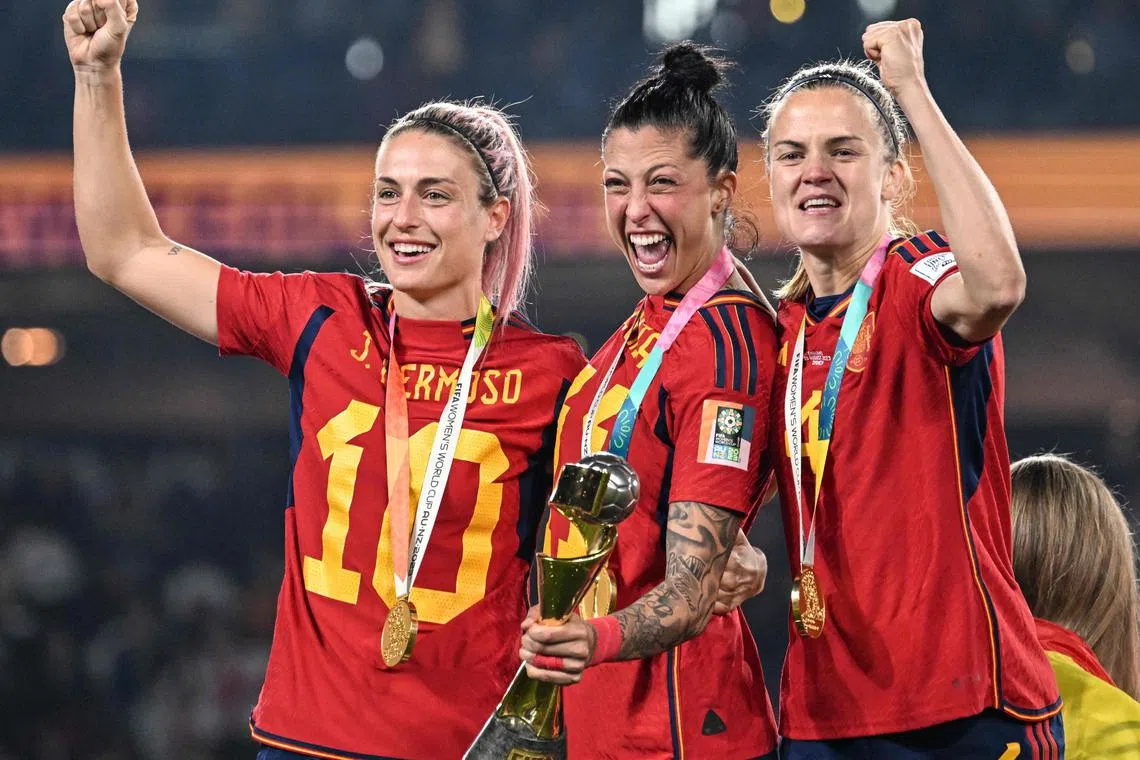Success of Women’s World Cup can’t hide financial gap with men
Sign up now: Get the biggest sports news in your inbox

Spain players celebrating with the trophy after beating England 1-0 to win the Women's World Cup at Stadium Australia in Sydney on Aug 20.
PHOTO: AFP
Follow topic:
STOKE – Just a few years ago, pre-season training for Stoke City’s women sometimes included painting the dugout and removing litter from the pitch at a former working men’s club in central England.
Now, in line with a global boom in women’s football, they are being paid, receive instructions from a full-time coach, enjoy the same multi-million pound training facilities as the men – and no longer moonlight as rubbish collectors.
“In such a short time, we’ve seen massive changes,” said 24-year-old midfielder Molly Holder, in her third campaign at Stoke.
“We go early to use the gym, we have access to the physio, 20 minutes in the video analysis room, maybe some darts and food with teammates. We feel part of Stoke.”
That professionalisation has underpinned the success of the ninth Women’s World Cup, which ended on Sunday with Spain beating England 1-0
Attracting record crowds and television audiences, the tournament buoyed hopes that the women’s game can start to bridge the yawning financial gap that exists with the men.
According to consultancy Deloitte, the women’s teams of the highest revenue-generating clubs in world football accounted for less than 1 per cent of total club revenues.
Spain’s captain Olga Carmona – the scorer of Sunday’s deciding goal – plays for Real Madrid, where the women’s team generated revenues of €1.4 million (S$2.06 million) in the 2021-22 season, while their men’s teams raked in €713.8 million, according to Deloitte.
TV blackout
In broadcast rights, the women’s game has struggled to compete. Fifa president Gianni Infantino threatened Europe’s big five nations with a TV World Cup blackout unless their broadcasters upped their offers. According to Fifa, broadcasters from Britain, Spain, France, Germany and Italy offered only US$1 million (S$1.35 million) to US$10 million for the right to show World Cup games. That compared with the US$100 million to US$200 million paid for the men’s tournament.
“We had to arm-wrestle some people to take the TV deals,” said Jill Ellis, the coach who led the United States to World Cup triumphs in 2015 and 2019 and who now leads Fifa’s technical committee.
British broadcaster the BBC released figures on Monday showing that 12 million watched all or part of Sunday’s final live on the BBC alone, beating the Wimbledon men’s final in July which drew 11.3 million viewers on the BBC. The World Cup final was also shown on rival channel ITV which has not released figures.
In Spain, 8.8 million people tuned in to watch at least some of the match on TV, according to audience measurement firm Barlovento.
The question now is whether the vast audiences that tuned in to the World Cup can lead to larger broadcast rights and sponsorship deals for national sides and the domestic clubs that are needed to sustain interest outside of major tournaments.
“Women’s football domestically is still in start-up phase. So it’s a matter of investing,” Lisa Parfitt, director of Women in Football and co-founder of sports marketing agency The Space Between, told Reuters of the game in general.
England’s success at Euro 2022, where 17.4 million people tuned in to watch the Lionesses beat Germany in extra time, has shown what can happen when a team’s success becomes part of the national conversation. The viewing figures did not include those watching in big fan parks and pubs.
Game changer
Kieran Maguire, at the University of Liverpool, said the England national side then surpassed expectations by selling out Wembley stadium twice for matches outside major tournaments.
But he said the domestic Women’s Super League (WSL) had a tougher challenge as it, like other sports, has to contend with the monster that is the men’s Premier League, which dominates the media and broadcast schedules as the world’s best players line up for the likes of the Manchester rivals, Chelsea and Liverpool.
Still, attendances at the WSL rose by 170 per cent on the year before to an average of 5,222, with a record of 47,367 fans set by Arsenal. The number of women registering to play football in general rose by 16 per cent.
The women’s game also has something different to offer.
According to Simon Chadwick at the Skema Business School in France, major brands have always advertised around the men’s game because they know they will reach millions of viewers and make a return on their investment.
But both Chadwick and Carlota Planas, a Spain-based women’s football agent representing several World Cup players, argued that the women’s game now offers the values of tenacity, resilience and togetherness, which can appeal to advertisers.
“(The players) have had to fight a lot, overcome many barriers, break many ceilings, to get to where they are. That dream, that enthusiasm, that we have fought for and achieved, is what excites people and makes them hooked,” Planas said.
Back in Stoke that determination is on display, both among the newly semi-professional women’s team and on myriad pitches in nearby villages where eager parents cheer on their daughters.
“Hopefully, after this World Cup, more and more people are going to wake up on a Sunday and think ‘Our local team are playing, let’s go and watch them’,” Holder said. REUTERS

